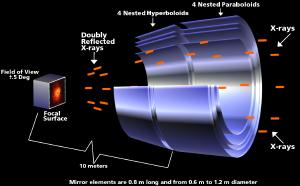Post
Ingredient X
25 November 2012
 NASA/CXC/D.Berry
NASA/CXC/D.BerryIn observational astronomy it’s always good to gather more data. Sometimes this is achieved by making more observations, but at other times it is achieved by making observations at different wavelengths of light. You’re probably most familiar with observations made in the visible spectrum. After all, it is how we observe things with the naked eye, which is how astronomy was done for thousands of years.
In the 1930s we started building radio telescopes, which opened a whole new realm of observational possibilities. Expanding observations to even more wavelengths was a bit of a challenge because our atmosphere tends to absorb light in the infrared, at large radio wavelengths, and at wavelengths shorter than visible light. This is generally a good thing, because things like ultraviolet light and x-rays tend to be harmful to us. It means, however, that to observe these wavelengths we have to get above the atmosphere. For this reason, satellites capable of ultraviolet and x-ray astronomy didn’t appear until the 1970s.
X-ray astronomy presents an additional challenge because you not only have to put your x-ray telescope in space, you also have to build your telescope very differently. A visible or radio telescope typically uses a curved surface that acts as a mirror to reflect light back to your camera or detector. But the wavelengths of x-rays are so short they act almost like tiny bullets. If you tried to use a curved surface to reflect x-rays back to your detector, the x-rays would simply pierce through your “mirror.”
To focus x-rays, then, you have to use a series of slightly curved surfaces aligned so that the x-rays glance off the surface at a shallow angle, as you can see in the figure below. This means x-ray telescopes have to be fairly large. The Chandra telescope, for example, is more than 40 meters long, compared to the Hubble telescope, which is about 10 meters long. It also makes it more difficult to make high resolution images. Chandra’s resolution is about 1/2 an arcsecond, which is roughly the apparent size of the minor planet Ceres as seen from Earth.
The big advantage, of course, it that x-ray astronomy lets us observe many of the phenomena that occur at high energies, such as black holes and supernova.